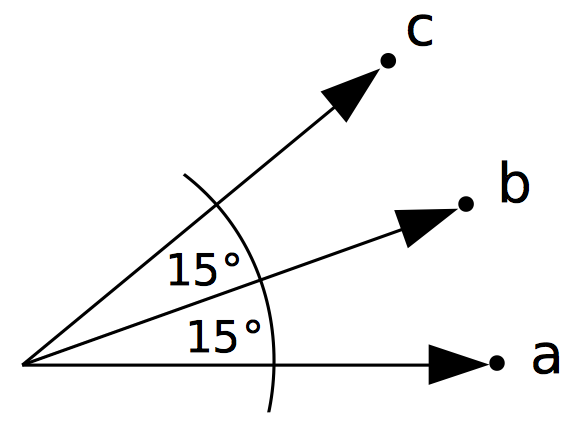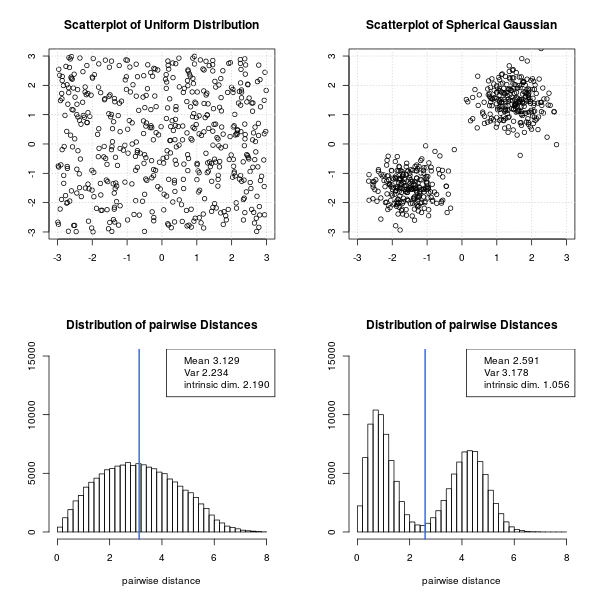
The cosine measure is the prevailing similarity function for the document vector model of IR. We discuss a its connection to the intrinsic dimension.
Mostly only two reasons are given for choosing the cosine measure: Comuptational efficiency and favorable modelling properties. But there is annother important reason, namely reducing the intrinsic dimension of the vector space.
The cosine measure is the prevailing similarity function for the document vector model of information retrieval, see Salton1975 (1). Very often only two reasons are given for choosing the cosine measure as a similarity function:
Not so often following motivation for using a semimetric (the triangle inequality doesn't hold, see section Cosine Similarity for a discussion) is given.

The similarity between two document vectors $d_i$ and $d_j$ is calculated as the cosine of the enclosed angle $\theta = \angle(d_i, d_j)$:
$$ sim(d_i, d_j) = cos(\theta) = \frac{d_i^T d_i}{\|d_i\|\cdot \|d_j\|}. $$
The dissimilarity funtion $1-cos(\theta)$ induced by cosine similariy is not a metric but semi-metric. That is the triangle inequality doesn't hold. This is clear when we look at the functional form of $1-cos(\theta)$:

To (re)produce the above image you can use the following R script:
# change to working directory
setwd("~/Pictures")
# domain values for x
x = seq(0,pi/2,length.out=21)
# x-axes and y-axes labels to print
x_label_val = seq(0,pi/2,length.out=7)
x_label_print = 2*x_label_val/pi*90
y_label_val = 1.0-cos(x_label_val)
# plot plot graph
png("cosine.png", width = 800, height = 800, res=100)
plot(x,1-cos(x), t="l", main="Cosine Dissimilarity", xlab="Angle in Degrees",
ylab="Distance 1-cos(x)",xaxt="n", yaxt="n");
lines(x_label_val,1-cos(x_label_val), t="p");
# print x-axis and y-axis
axis(1,x_label_val,labels=x_label_print)
axis(2,y_label_val,labels=round(y_label_val,3),las=1)
# print grid lines
abline(h=y_label_val, col="grey", lty=3)
abline(v=x_label_val, col="grey", lty=3)
dev.off()
Lets look at three vectors a, b and c where $$\angle(a, b)=\angle(b, c)=15^\circ,\quad\angle(a, c)=30^\circ.$$

From the plot of angles versus cosine distance above wee see that $$d(a,b)=d(b,c)\approx 0.034,\quad d(a,c)\approx 0.134.$$ So $$d(a,b)+d(b,c)\lt d(a,c)$$ which obviously violates the triangle inequality which postualtes $$ d(a,b)+d(b,c) \geq d(a,c).$$
When we consider a document collection as a set of points (vectors) in a vector space we have to consider different definitions of dimension.
One way to define an intrinsic dimension is the following:
\begin{equation} \rho = \frac{\mu^2}{2\sigma^2}, \end{equation}
where $\mu$ is the average distance between two document vectors and $\sigma^2$ the variance of the pairwise distances, for details see Skobal et.al. 2004 (4). In other words, if all pairs of document vectors are almost equally distant (the data set is uniformly distributed) $\sigma$ becomes small and therefore the dimension $\rho$ becomes large. On the other hand if the distance between nearby points is small (intra cluster distance) and the distance between further distant vectors is big (inter cluster distance) the mean gets faster smaller than the variance which in turn decreases the dimension $\rho$. Skobal et.al. (4) write:
On the other side, the convex modifications [...] even more tighten the object clusters, making the cluster structure of the dataset more evident. Simply, the convex modifications increase the distance histogram variance, thereby decreasing the intrinsic dimensionality.
Lets look at an synthetic example in the 2-dimensional plane:

Here is the R-project code to drqa the above plot:
library("MASS")
plot_rho = function(s1, s2, t1, t2) {
d1 = dist(s1)
d2 = dist(s2)
rho1 = mean(d1)^2 / (2 * var(d1))
rho2 = mean(d2)^2 / (2 * var(d2))
par(mfrow=c(2,2)) # combine plots in 2 x 2 layout
limits = c(-3,3) # limits for scatter plot
plot(s1, xlab="", ylab="", main=sprintf("Scatterplot of %s", t1), xlim=limits, ylim=limits); grid()
plot(s2, xlab="", ylab="", main=sprintf("Scatterplot of %s", t2), xlim=limits, ylim=limits); grid()
hist(d1[d1 < 8], breaks=seq(0,8,by=0.2), ylim=c(0,15000), main="Distribution of pairwise Distances", xlab="pairwise distance", ylab="")
abline(v = mean(d1), col = "royalblue", lwd = 2)
legend("topright", c(sprintf("Mean %.3f", mean(d1)),sprintf("Var %.3f", var(d1)),sprintf("intrinsic dim. %.3f", rho1)))
hist(d2[d2 < 8], breaks=seq(0,8,by=0.2), ylim=c(0,15000), main="Distribution of pairwise Distances", xlab="pairwise distance", ylab="")
abline(v = mean(d2), col = "royalblue", lwd = 2)
legend("topright", c(sprintf("Mean %.3f", mean(d2)),sprintf("Var %.3f", var(d2)),sprintf("intrinsic dim. %.3f", rho2)))
}
#
# spherical normal distribution
#
Sigma = matrix(c(0.25,0,0,0.25),2,2)
s_sphere1 = mvrnorm(n = 250, c(-1.5,-1.5), Sigma) # sample multivariate normal with correlation matrix Sigma
s_sphere2 = mvrnorm(n = 250, c(1.5,1.5), Sigma) # sample multivariate normal with correlation matrix Sigma
s_sphere = rbind(s_sphere1, s_sphere2)
#
# Uniform random numbers
#
s_uni = matrix(runif(1000, -3,3), nrow=500)
setwd("~/Pictures")
png("intrinsic_dim.png", width = 800, height = 800, res=100)
plot_rho(s_uni, s_sphere, "Uniform Distribution", "Spherical Gaussian")
dev.off()
In structured high dimensional vector spaces the cosine similarity helps to reduce the intrinsic dimension and therefore helps to avoid or reduce problems connected to the curse of dimensionality. For example clustering algorithms in the vector space model of information retrieval may benefit from this property.
Bibliography
[1] Gerard Salton, A. Wong, C. S. Yang. A vector space model for automatic indexing. Commun. ACM 18(11): 613-620 (1975).
[2] Gerard Salton and Christopher Buckley. Term-weighting approaches in automatic text retrieval. Elsevier, Information Processing and Management, Volume 24, Issue 5 (1988).
[3] Manning, Christopher D. and Raghavan, Prabhakar and Schütze, Hinrich. Introduction to Information Retrieval". Cambridge University Press 2008.
[4] Tomáš Skopal, Pavel Moravec, Jaroslav Pokorný, Václav Snášel Metric Indexing for the Vector Model in Text Retrieval. String Processing and Information Retrieval: 11th International Conference, SPIRE 2004, Padova, Italy, October 5-8, 2004. Proceedings.